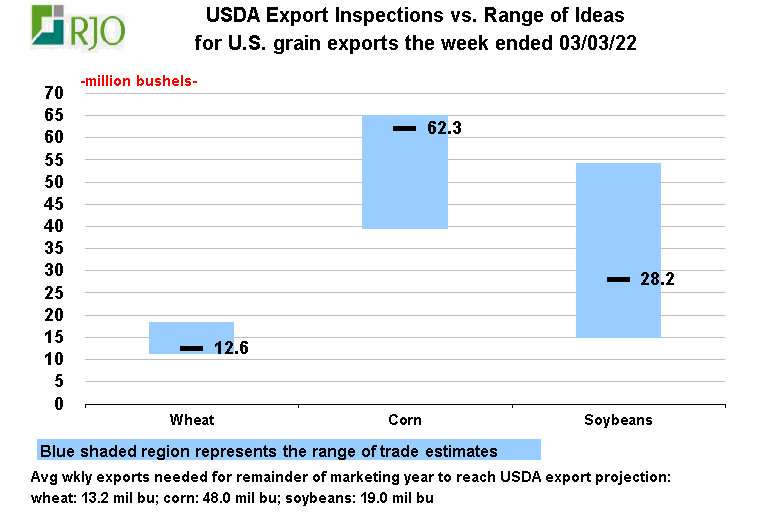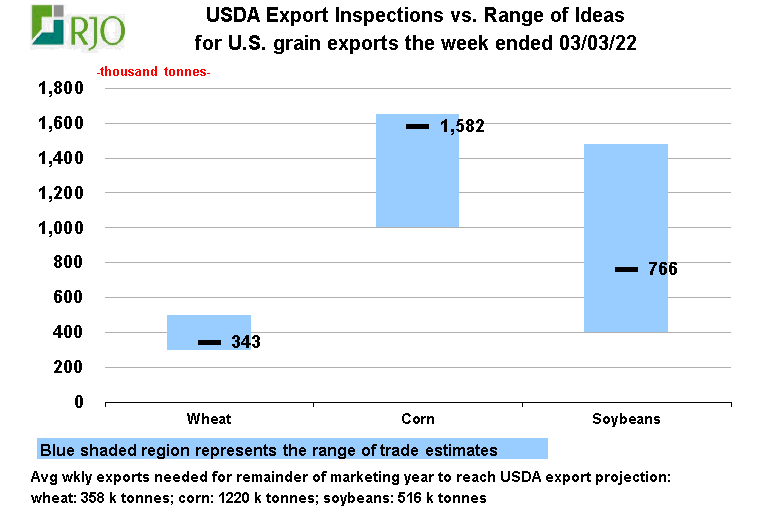-Corn exports at top of expectations – marketing year high
-Soybean exports as expected
-Wheat exports at bottom of expectations
U.S. corn exports, for the week ended 3/03/22, were 1.582 MMT (62.3 million bushels), at the top end of market expectations of 1.0-1.65 MMT (39.4-65.0 mil bu), up marginally from the previous week’s 1.555 MMT (61.2 mil bu) and were a marketing year high, but were slightly below last year’s same-week exports of 1.682 MMT (66.2 mil bu). This week’s activity included a solid 555k tonnes shipped to China, leaving their unshipped 2021/22 U.S. corn purchases at roughly 6.5 MMT based on last week’s Export Sales data vs 11.3 MMT in outstanding sales at this time last year. Corn exports have clearly accelerated of late and have been quite consistent, averaging 60.7 million bushels/week over the last four weeks and in a tight range of 57.3-62.3 million bushels. With cumulative export inspections at 976 million bushels vs 1.099 billion last year, down 11%, we estimate weekly inspections will need to average roughly 48.0 million bushels/week through the end of August to reach the USDA’s 2.425 billion bushel export projection vs last year’s 57.6 million/week average from this point forward when taking into account the difference between Inspections and official Census Bureau export data. We continue to feel 2021/22 exports are likely to prove higher than the USDA’s current estimate, as we’re using 2.500 billion bushels in our balance sheet, and see the potential for higher exports yet pending developments in the Russia/Ukraine situation.
U.S. soybean exports last week were 766k tonnes (28.2 million bushels), little-changed from the previous week’s 738k tonnes (27.1 mil bu) and last year’s same-week exports of 666k tonnes (24.5 mil bu), while falling in line with extremely wide market expectations of 400k-1.475 MMT (14.7-54.2 mil bu). This week’s activity included 244k tonnes shipped to China, leaving their unshipped 2021/22 U.S. soybean purchases somewhere around 1.8 MMT vs 1.15 MMT at this time last year taking into account the USDA’s daily sales announcements since last week’s Export Sales report “as of” date. Cumulative export inspections of 1.520 billion bushels are still down 21% from last year’s 1.939 billion vs the USDA’s 2.050 billion bushel export projection reflecting an estimated 9.5% decline in soybean exports for the year so there is continued work to be done in order to close the current gap relative to last year. Over the last three weeks, U.S. soybean exports averaged 31.2 mil bu/week, nearly identical to last year’s 30.3 million/week during the same period. We continue to feel the short South American soybean crop will allow exports to prove larger than the USDA is currently projection, as we’re at 2.125 billion bushels in our balance sheet, but may not become evident via weekly shipping activity until later in the marketing year once the bulk of seasonal South American exports begin to wind down. We estimate soybean exports would need to average roughly 19.0 million bushels/week through the end of August to reach the USDA’s current export projection vs last year’s tepid 9.3 million/week average from this point forward.
U.S. wheat exports remain lackluster with 343k tonne (12.6 mil bu) shipped last week, down from the previous week’s 430k tonnes (15.8 mil bu), well below year ago same-week exports of 523k tonnes (19.2 mil bu) and at the bottom end of market expectations of 300-500k tonnes (11.0-18.4 mil bu). Despite all the Russia/Ukraine concerns, the U.S. wheat export program continues to labor, with last week’s exports being the lowest in 8 weeks. Cumulative export inspections of 583 million bushels are down 15% from last year’s 686 million vs the USDA’s 810 million bushel export projection reflecting an estimated 18% decline from last year, leaving export inspections needing to average roughly 13.2 million bushels/week through the end of May in order to reach their export estimate vs last year’s solid 20.2 million/week average from this point forward. We are using annual exports of 825 million bushels in our U.S. wheat balance sheet currently, but are leery of going any higher for now, despite the notable issues/concerns with Black Sea exports, given the uninspiring export activity for U.S. supplies of late and only three months remaining in the marketing year.


